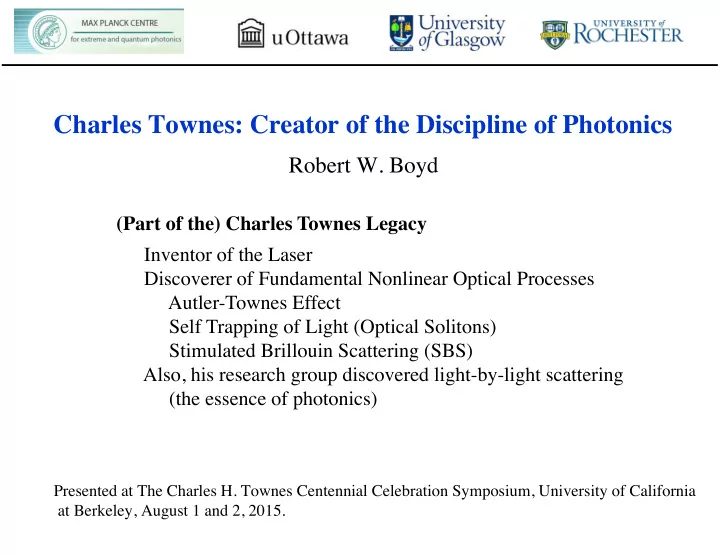

Charles Townes: Creator of the Discipline of Photonics Robert W. Boyd (Part of the) Charles Townes Legacy Inventor of the Laser Discoverer of Fundamental Nonlinear Optical Processes Autler-Townes Effect Self Trapping of Light (Optical Solitons) Stimulated Brillouin Scattering (SBS) Also, his research group discovered light-by-light scattering (the essence of photonics) Presented at The Charles H. Townes Centennial Celebration Symposium, University of California at Berkeley, August 1 and 2, 2015.
What is Photonics? And how is it different from optics? Answer 1: Optics is old name Photonics is new name Answer 2: “Optics” has always been a misnomer. Optos is Greek for vision. Photos is Greek for light. Answer 3: Photonics is doing useful things with light. (As in the distinction between electronics and electricity.)
Essence of Photonics: Light-by-Light Scattering The elementary process of light-by-light scattering has never been observed in vacuum, but is readily observed using the nonlinear response of material systems. See also Carman, Chiao, and Kelley, Phys. Rev. Lett. 17, 1282 (1966).
Photonics is a US National Priority Joe Biden announces that Rochester will host the Institute for Manufacturing Innovation in Integrated Photonics (a part of the National Photonics Institute), July 27, 2015. Funding for five years to exceed $600 Million. Photonics has a huge commercial impact: a $150 billion yearly market, world wide.
THE SCHAWLOW-TOWNES SYMPOSIUM ON PHOTONICS THE SCHAWLOW-TOWNES SYMPOSIUM ON PHOTONICS IS NAMED IN HONOUR OF CHARLES H. TOWNES AND THE LATE ARTHUR L. SCHAWLOW, PIONEERS IN LASER TECHNOLOGY. For this inaugural event, the University of Ottawa is delighted to present the following internationally acclaimed keynote speakers: Erich Ippen Gerd Leuchs Charles H. Townes World-renowned expert in Director, Max Planck Institute for Nobel laureate in physics for femtosecond optics, Massachusetts the Science of Light, Germany his groundbreaking work in Institute of Technology quantum electronics Friday, November 9, 2012 1 p.m. to 4 p.m. Ottawa Convention Centre, Room 204 55 Colonel By Drive, Ottawa, Ontario Also on that day: 9:30 a.m. to 12 p.m. Presentations by Olga Smirnova (Max Born Institute, Berlin) Albert Stolow (National Research Council of Canada) Ksenia Dolgaleva (University of Toronto) Jefg Lundeen (National Research Council of Canada) Seating is limited. Register online (free). For more information: judith.lachance@uottawa.ca
One of My Contributions to the Field of Photonics First Edition 1992, Second Edition 2003, Third Edition 2008.
Some of My Research Projects (But only the fun projects!)
Controlling the Velocity of Light “Slow,” “Fast” and “Backwards” Light – Light can be made to go: v g << c (as much as 10 6 times slower!) slow: v g > c fast: v g negative backwards: Here v g is the group velocity: v g = c/ n g n g = n + ω (d n /d ω ) – Velocity controlled by structural or material resonances absorption profile Review article: Boyd and Gauthier, Science 326, 1074 (2009).
How to Control the Group Velocity of Light absorption gain α g resonance resonance ω ω ω 0 ω 0 n n ω ω slow light ng ng ω slow light fast light ω fast light n g = n + ω (d n /d ω )
andChiao(1993). Schweinsberg,Barsi, andMcCumber(1970) •PredictedbyGarrett phenomenon Kostinski,andBoyd Observation of Superluminal and “Backwards” Pulse Propagation - conc eptualp r edi c tion -lab or at or y r esults •Ast r ongly coun t erin tuiti v e n g negative • B ute n ti r ely c onsist en twith establishedph y sics Δ t = 0 Δ t = 3 Δ t = 6 Δ t = 9 Δ t = 12 •Observedby G eh ring, Δ t = 15 Scien c e312 , 9852006. Propagation distance 5 -1 -0.5 0 0.5 1x10 Normalized length |n g |Z (m)
Observation of Rotary Photon Drag The world as seen through a spinning window. (Laser-excited ruby has a group index of 10 6 .) Experimental setup rotating, 10-cm-long ruby rod ! Effect clearly visible by eye! Franke-Arnold, Gibson, Boyd and Padget, Science, 2011
Observation of Optical Polarization Möbius Strips Möbius strips are familiar geometrical structures, but their occurrence in nature is extremely rare. We generate such structures in the nanoscale in tightly focused vector light beams and confirm experimentally their Möbius topology. This work demonstrates that focused optical fields can possess complex structure at sub- wavelength distances and that advances in nano-optics provide the tools to probe these features. Bauer, Banzer, Karimi, Orlov, Rubano, Marrucci, Santamato, Boyd and Leuchs, Science 347, 964 (2015)
Townes and Portraits Charles H. Townes c Yousuf Karsh, Ottawa, 1970. Reprinted with permission .
Recommend
More recommend